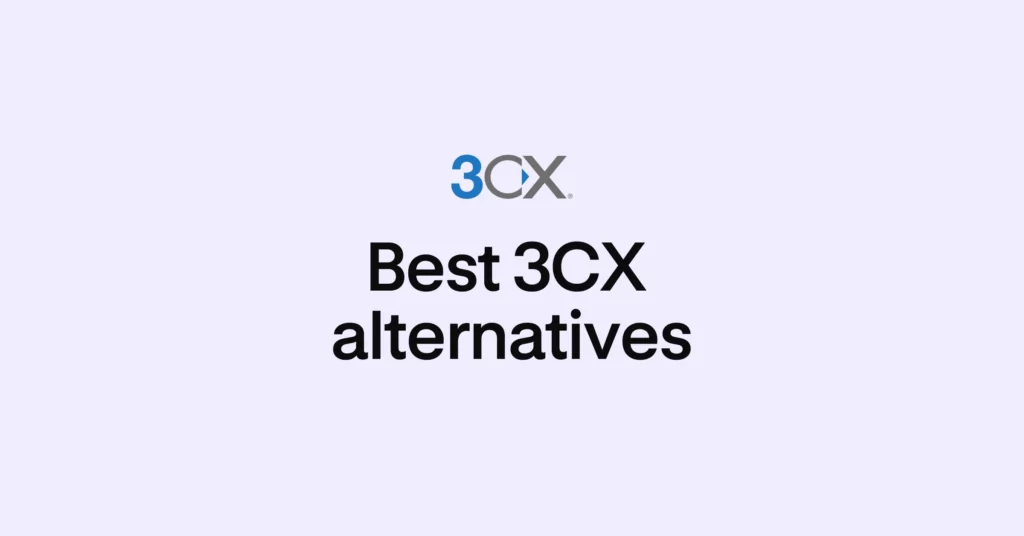Looking for a better option beyond 3CX?
If you’re fed up with hidden fees and security issues, check out the nine top 3CX alternatives in this article.
Let’s dive in.
How the 9 top 3CX alternatives compare side by side
Here are the fast facts on all nine 3CX alternatives:
| Provider | Price | Unlimited calling to US & Canada | Free SMS, MMS to US & Canada | Shared phone numbers | Additional phone numbers |
|---|---|---|---|---|---|
| 3CX | Starts at $0 per user per month | Depends on SIP trunk | Requires upgrade | x | x |
| OpenPhone | Starts at $15 per user per month | ✓ | ✓ | ✓ | $5 per number p month |
| RingCentral | Starts at $20 per user per month | ✓ | X | Requires upgrade | $4.99 per number per month |
| Vonage | Starts at $19.99 per user per month (1-year contract) | ✓ | Local US and Canadian numbers only | Requires upgrade or $4.99 add-on for each call group | $14.99 per number per month |
| Zoom Phone | Starts at $10 per user per month | Unlimited inbound only with upgrade | US & Canadian numbers only | $250 per user per year | $5 per number per month |
| Nextiva | Starts at $23.95 per user per month | ✓ | Requires upgrade | ✓ | Requires the purchase of an additional user seat |
| GoTo Connect | Starts at $24 per user per month | X | For US & Canadian customers only | ✓ (up to 8 phones) | $5 per number per month |
| 8×8 | Starts at $24 per user per month | ✓ | X | ✓ | $5 per number per month |
| Genesys Cloud CX | Starts at $75 per user per month | X | SMS only | x | Undisclosed price |
| Aircall | Starts at $30 per user per month | ✓ | SMS only | ✓ | $6 per number per month |
Now that you’re familiar with each alternative, here’s a deep dive into everything you should know — starting with the #1 business phone solution on G2.
1. OpenPhone: The best 3CX alternative for growing teams
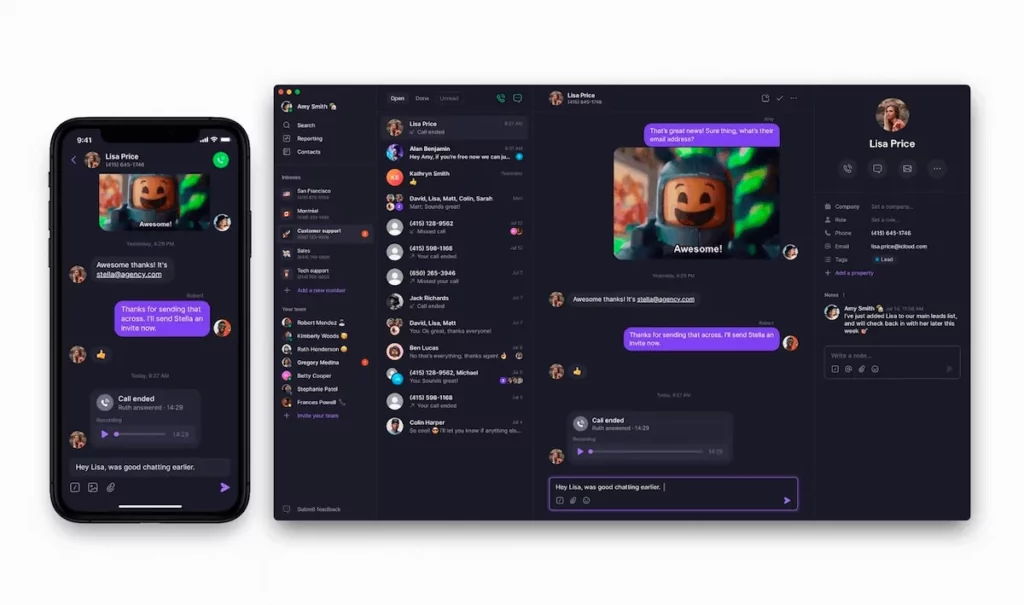
OpenPhone is a virtual phone system built for startups and growing small businesses. You can get a local US, Canadian, or toll-free number from almost anywhere in the world. Then, you can make or take phone calls from anywhere with a WiFi connection.
OpenPhone offers far more flexibility for your team than 3CX. You’re never required to purchase new equipment (like SIP trunks) to install on your own. Instead, your team can call and text from the devices they already own, including their computers, laptops, and smartphones. There’s no physical hardware required — and signing up takes just 15 minutes.
How to get a virtual number with OpenPhone
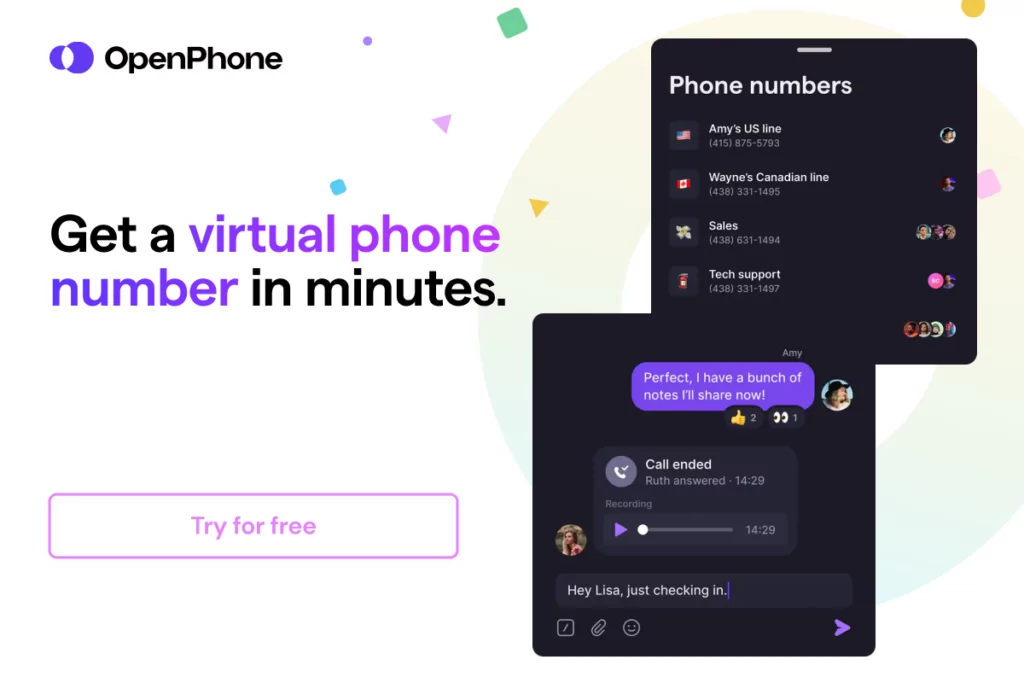
Getting a new phone number from almost anywhere in the world is a simple process when you choose OpenPhone as your virtual phone number provider. Follow these three steps:
- Create an account with OpenPhone (when you sign up, you get a free, seven-day trial).
- During signup, choose your city or area code in the US to select your preferred phone number.
- Once the signup process is complete, you’re all set to use your new virtual phone number!
OpenPhone also makes it easier to share responsibility for incoming calls. With 3CX, a team of 10 can only be on up to four calls simultaneously. Using OpenPhone’s shared numbers, up to 10 users can call and text from a single phone number with our Starter plan ($15 per user per month). On our Business plan, up to 100 users on your team can call and text through the same number.
Plus, collaboration in context with your team’s inbox is easy. You can tag teammates inside contact threads to assign out tasks and ask your colleagues questions. You can also set the standard to leave an internal comment containing additional information to help your team deliver better customer experiences.
Looking to manage your team more effectively? With OpenPhone, you can easily see who on your team has been in touch with specific contacts (and make sure customers get the attention they need). Plus, you can listen back to call recordings in context with the rest of the conversation to coach teammates as needed.
OpenPhone’s SOC 2-compliant platform helps you build better relationships with your customers in multiple ways. For example:
- Unlike 3CX, you don’t need to upgrade to a higher-tier plan to get SMS and MMS. Your team can save time texting with scheduled messages, auto-replies, and snippets.
- You can connect your tech stack with your business phone number to automate routine tasks. We integrate with CRMs like Salesforce and HubSpot and can help everyone on your team stay in the loop through Slack.
- Want to automate even more daily tasks? With Zapier, you can connect OpenPhone to 5,000+ other platforms and create workflows that run while you sleep. For example, you can send automated appointment reminders when customers fill out a form on your website. You could also push data to your HubSpot CRM when you add a new contact on OpenPhone.
But the biggest benefit in the OpenPhone vs 3CX debate isn’t a feature at all — it’s just clear pricing upfront. You can easily see what you’d be paying on our pricing page and calculate monthly costs in minutes. Plus, you can easily get set up OpenPhone in 20 minutes (without getting bogged down by technical documentation or needing IT support).
OpenPhone is the easiest way to communicate with customers as you grow. But you don’t have to take our word for it — just check out our user reviews:
“OpenPhone worked out the best for me amongst TalkRoute, 3CX, and Google Phone. They provided a free trial for seven days. It was really easy to set up both the web app and the Android app, and their support was super quick. I was convinced.” — G2
“I was impressed with their lightning-fast learning curve. We could set up most of the features we needed just intuitively, while for a few complex ones, there are tons of video tutorials, online demos, and articles in their documentation. The price is also something; I’m from the era where you should have spent thousands of dollars to purchase expensive equipment, hire a professional to set it up for you, and then spend lots of effort to maintain the overall system. With OpenPhone, any non-tech specialist can do all that in a few days without purchasing any additional equipment.” — G2
You can try OpenPhone at any time with our seven-day free trial. Just pick a new number (or use that temporarily while you move your existing one over to OpenPhone) to test our features today.
OpenPhone key features
- Unlimited calls in the US and Canada
- Free SMS and MMS to any US or Canadian numbers
- Phone menu and interactive voice response (IVR) options
- One new phone number per user on your account
- Shared phone numbers
- Texting automations (snippets, scheduled messages, and auto-replies)
- Call recording
- Voicemail to text
- 5,000+ integrations
OpenPhone pricing
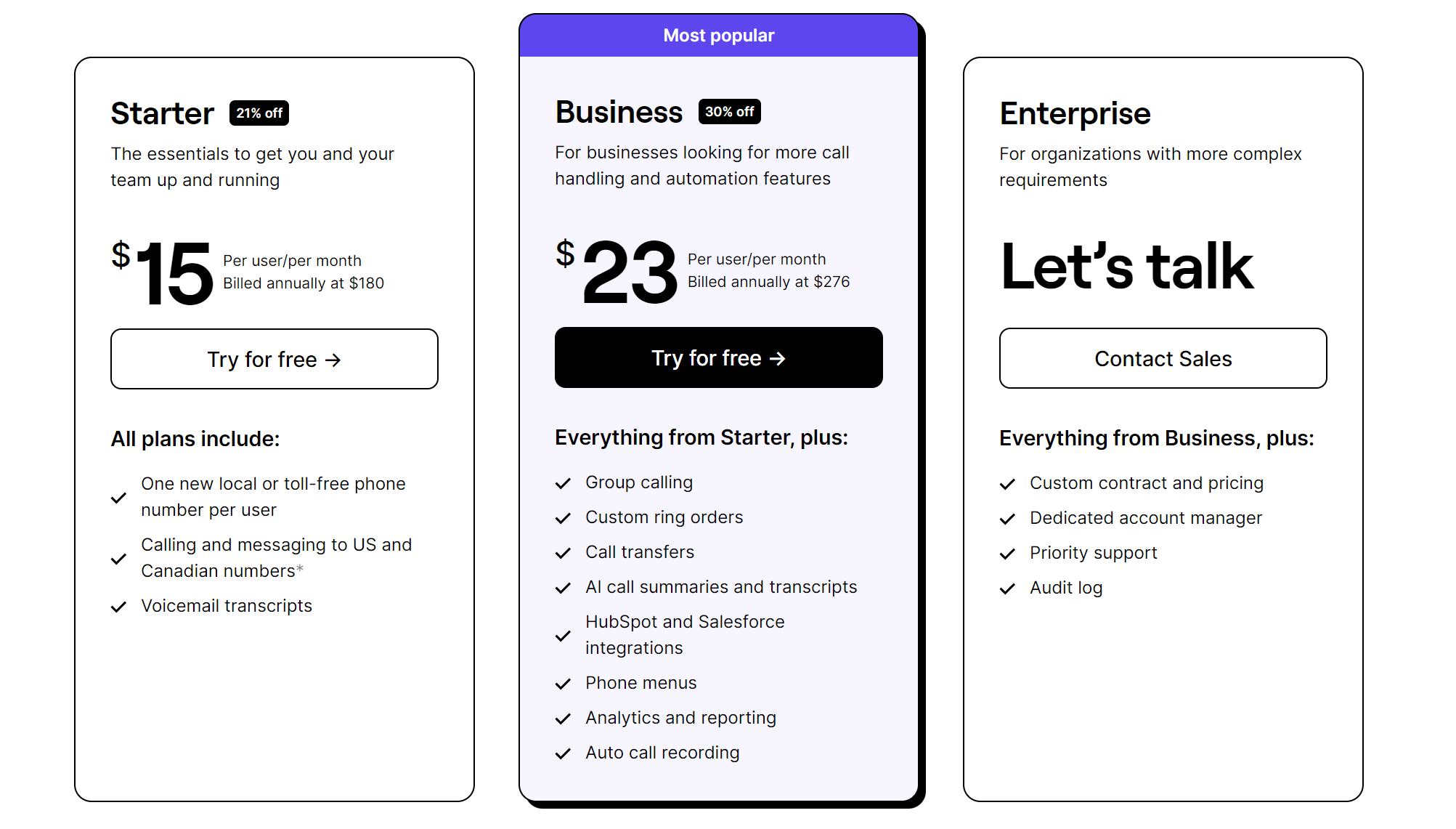
- Starter: $15 per user per month for unlimited calls in the US and Canada, SMS and MMS, automatic and on-demand call recording, and more
- Business: $23 per user per month for analytics and reporting, call transfers, and round-robin calls
- Enterprise: Get a custom quote for priority support, audit logs, and a dedicated account manager
2. RingCentral
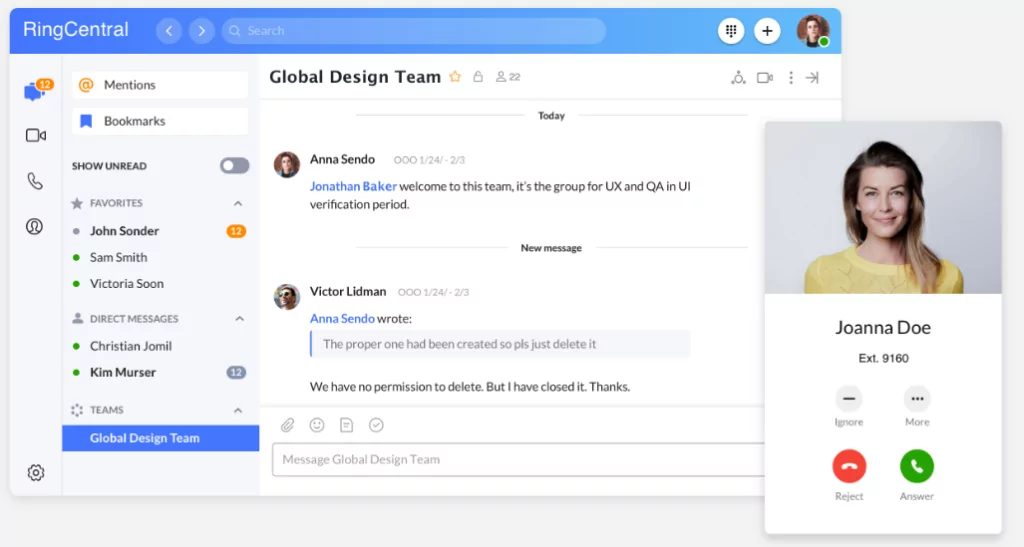
RingCentral is a unified communications platform with calls, texts, and video tools on the same plan. With RingCentral, you can use AI tools to automatically transcribe video meetings or reduce background noise that may affect call quality.
But the actual features you get on RingCentral’s basic plan are limited at best. Their base-level subscription only includes up to 25 SMS messages per month. For any text messages beyond that, you’ll pay per message. You also can’t access voicemail to text or automatic call recording unless you move to the next tier. Plus, upgrading may not be enough to support your team as it grows. You’re limited to just 10,000 toll-free minutes, 200 SMS messages per user, and one year of storage on the most expensive plan ($35 per user per month).
Perhaps the most frustrating limitation of RingCentral’s platform is the lack of unlimited storage:
- You can’t keep more than 5,000 SMS messages per user.
- Recorded calls are only kept in call logs for up to 90 days.
- You can’t have more than 100,000 call recordings per account. Older records get erased when you record new material.
- Even if you upgrade to Ultra for ‘unlimited’ storage ($35 per user per month), you’re still subject to time-based deletion schedules.
Want a business phone solution that doesn’t force you to upgrade for storage? You should look into RingCentral alternatives instead.
RingCentral key features
- Unlimited domestic calls in the US and Canada
- SMS and MMS support (25 messages per user per month on the Core plan)
- IVR
- Integrations with Microsoft and Google
- Video calls
RingCentral pricing

- Core: $20 per user per month of 25 SMS messages per user, on-demand call recording, and IVR
- Advanced: $35 per user per month for 100 SMS messages per user, automatic call recording, and voicemail transcription
- Ultra: $35 per user per month for 200 SMS messages per user, up to 200 video participants, and device analytics and alerts
3. Vonage
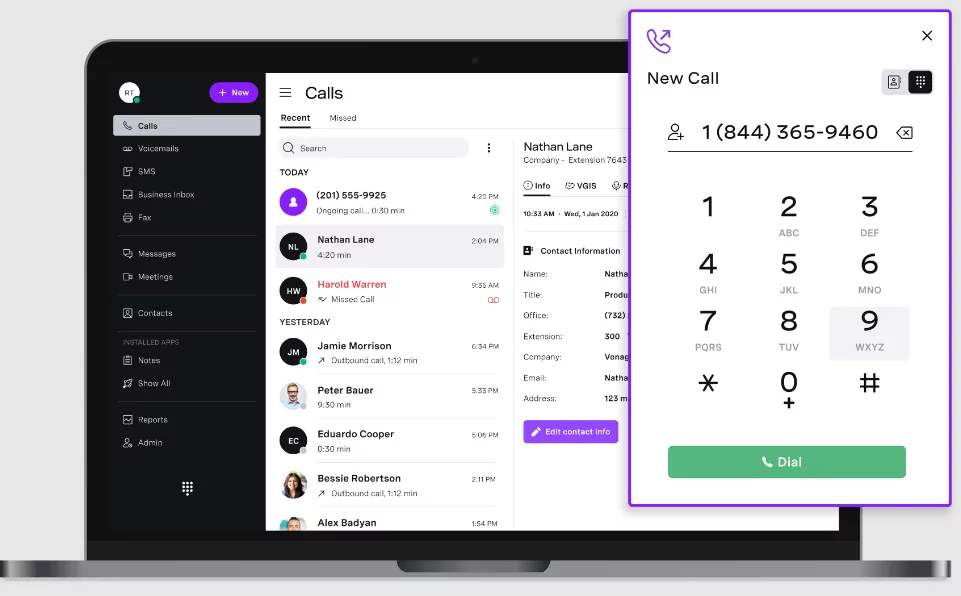
Vonage is a VoIP provider that offers both pre-built plans and APIs. You can use Vonage’s business phone service to access 50 basic features. Alternatively, you can dig into the APIs to build a solution.
But if you look at Vonage’s pre-built plans, keep in mind they come with their own limitations. More than 18 of their features require paid add-ons, including:
- Automatic call recording ($49.99 per month)
- Conference bridges ($14.99 per month)
- Personalized customer support ($9.99 per month)
And keep in mind not all of Vonage’s features are available in all countries. If you’re based anywhere in APAC or EMEA, you can’t access:
- Paperless fax
- Business inbox (for cross-channel texting)
- Toll-free numbers
Rather code your own calling solution? Keep in mind this isn’t free — Vonage’s APIs aren’t open source, so you need to pay if you want to implement them into your existing software.
Vonage gives you plenty of options to customize your communication tools — but only if you have the right time, talent, and business location. When you add up the costs of hiring a developer or handling code yourself, Vonage may require more work than your team can manage.
Vonage key features
- Mobile and desktop apps
- Unlimited calls in the US, Canada, and Mexico
- Texts in the US and Canada
- 20 third-party integrations (like Clio or the G-Suite)
- Internal team messaging
Vonage pricing

Vonage’s prices depend on your team’s size. This means SMBs with fewer users have to pay more per user for the same service.
Here’s what Vonage costs for teams of one to four users:
- Mobile: $19.99 per line per month for calls and texts in the US and Canada, unlimited team messaging, and 20+ integrations
- Premium: $29.99 per line per month for multi-level auto-attendants, CRM integrations, and the ability to connect with IP desk phones
- Advanced: $39.99 per line per month for visual voicemail, call groups, and on-demand call recording (15-hour max)
4. Zoom Phone
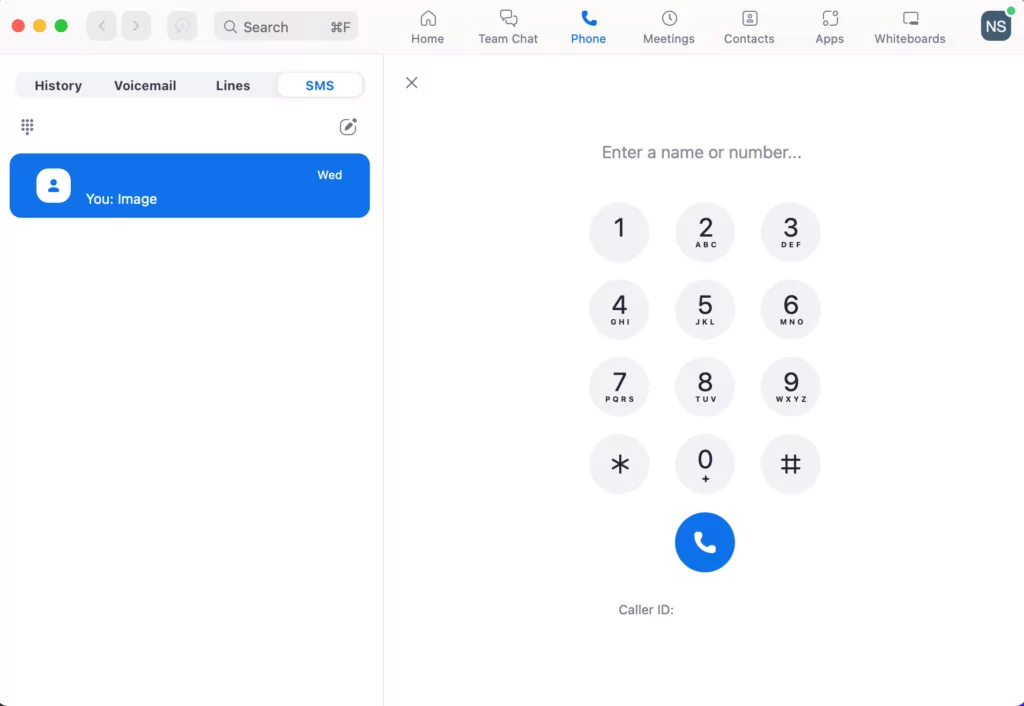
Zoom is a video communications tool with a separate platform specifically for VoIP. There are two distinct plans where you can get calling features: Zoom One and Zoom Phone.
Zoom Phone includes calling features only and does not come with Zoom’s video conferencing features. Although internal calls are always unlimited, outbound calls are metered unless you upgrade. Plus, many of the best features (like SMS and MMS) are locked behind more expensive plans. Just make sure you don’t upgrade too much, though — text messaging isn’t available on the most expensive plan.
With Zoom One, you can use business calling features with the rest of Zoom’s features (like video conferencing). However, the only plan compatible with Zoom Phone is Business Plus — $250 per year per user. But even then, the only way to unlock call queues and IVR is to upgrade to the Enterprise plan and get a custom quote. Just keep in mind you’ll get downgraded to metered outbound calls from unlimited regional calling, which is frustrating if you’re trying to grow your business.
If you’re migrating away from 3CX due to security concerns, Zoom Phone may not provide you with much peace of mind. Several major organizations have unsubscribed from their platform over security concerns.
If you still like the idea of a user-friendly phone system that teams can access through the cloud, you may want to check out some Zoom alternatives with a better track record.
Zoom key features
If you’re just using Zoom Phone, you can access features like:
- Unlimited internal calling
- Voicemail transcriptions
- Call recording
- Dial by name directory
- Five basic integrations
If you choose to buy Zoom One, you can also get:
- Team chat
- Whiteboards
- Video conferencing
Zoom pricing

As mentioned previously, Zoom One offers all the features of Zoom plus its business phone functionality. You have two plans to choose from:
- Business Plus: $250 per user per year for unlimited regional calling, domestic SMS and MMS, video meetings with 300 participants, and 10 GB of recording storage per license
- Enterprise: Custom quote for unlimited recording storage, call queues and IVR, metered outbound calls, and webinars
Just want to buy Zoom Phone? Here’s what you can expect to pay:
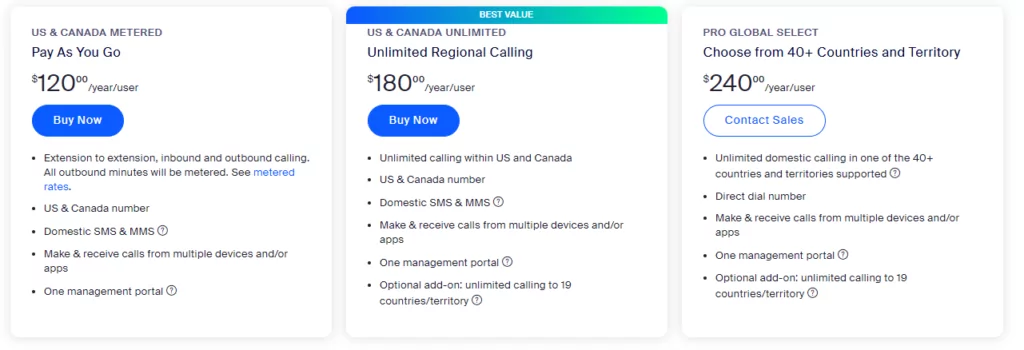
- Pro: Custom quote for unlimited internal calling, metered outbound calling, and all features except phone extension numbers and SMS and MMS
- Metered : $120 per user per year ($10 per user per month) for metered outbound calling SMS and MMS, and phone extension numbers
- Unlimited: $180 per user per year for ($15 per user per month) for unlimited outbound calling
- Select: $240 per user per year (20 per user per month) for unlimited domestic calling in 40+ countries and territories (but lose the ability to send SMS and MMS)
5. Nextiva
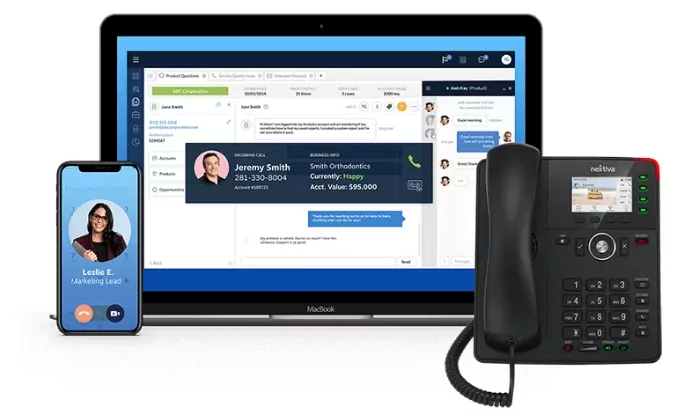
Nextiva is a VoIP service provider that bundles calling, texting, and video calling together. Although they offer an enterprise plan for contact centers, they also provide a small business plan for between one and 100 users (or more). Just keep in mind Nextiva is only available to business owners in the US.
Many of Nextiva’s previous customers say they outgrew the basic plan within a matter of months. It’s not hard to see why: there’s no way to access conference calls, SMS, or multi-level auto-attendants unless you upgrade to the Professional plan ($27.95 per user per month). Other critical features, including call recording and voicemail transcriptions, are locked behind an even more expensive plan ($37.95 per user per month). And no matter how much you upgrade, you can’t add more than 500 shared contacts or get unlimited toll-free minutes.
Plus, there’s no way to claim a free trial from Nextiva automatically — you have to contact the company for a demo first. This means you may spend more time filling out paperwork than trialing your potential phone service.
Nextiva key features
- Voicemail
- Toll-free numbers (no unlimited minutes)
- Unlimited internet fax
- Unlimited voice and video calling in the US and Canada
- Integrations with Outlook and Google Contacts
Nextiva pricing

Like Vonage and some other 3CX alternatives, Nextiva charges less money if you add more users to your plan. If you’re a smaller team of one to four users, you may have to pay steep prices for all three plans.
Here’s what teams of four users or less can expect to pay:
- Essential: $23.95 per user per month for basic auto-attendants, call groups, and voicemail to email
- Professional: $27.95 per user per month for screensharing, SMS and MMS, and Salesforce/HubSpot integrations
- Enterprise: $37.95 per user per month for call recording, voicemail transcriptions, and unlimited video conferencing recording
6. GoTo Connect
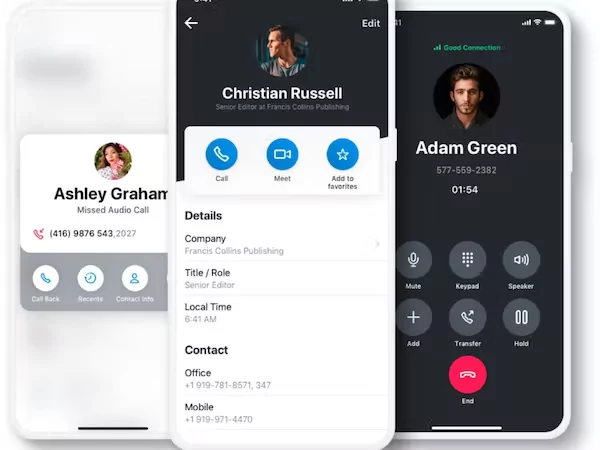
GoTo Connect offers call management software with additional add-ons depending on your needs. Apart from the base plans offering phone call and video features, you can sign up for their GoTo Customer Engagement suite or GoTo Contact Center tool to connect with customers on social media and monitor staff performance.
However, you should know most of GoTo Connect’s business model relies on add-ons and upgrades. You can’t even record calls unless you upgrade from the basic plan, which costs an additional $5 per user per month. You’re also limited by the number of users you can have on the basic plan. Once you reach 21 users, you’re forced to upgrade to the most expensive plan — even if you’re not ready for the included features.
But many of GoTo Connect’s included features come with their own set of limitations. Their base plan only lets you send up to 40 SMS messages per user per month and is only available to customers in the US and Canada. Anything beyond that and you’re paying extra.
You’re also capped at 1,000 pooled minutes for toll-free numbers, which is just 16.5 hours of call time per month for everyone on your plan. Every additional minute costs $.019 — which can add up fast if you’re only using a toll-free number.
Although GoTo Connect offers some decent customizable features, the countless upgrades can nickel and dime your business and limit your ability to make unlimited voice calls.
GoTo Connect key features
- Local and toll-free phone numbers
- Video meetings (up to four users)
- 40 SMS messages per user per month
- Integrations with Outlook and Google Workspace
- Auto-replies (for missed calls from first-time callers only)
GoTo Connect pricing

Like so many 3CX alternatives on this list, GoTo Connect’s pricing depends on the number of users on your account. The more you have, the less you pay — so the fewer you have, the more you pay.
Here’s the range for teams between two and ten users:
- Basic: $24 per user per month for call forwarding, ring groups, internal instant messaging, and 40 SMS messages per user per month
- Standard: $29 per user per month for call recording, real-time analytics, and 80 SMS messages per user per month
Other GoTo Connect add-ons (like GoTo Customer Engagement and GoTo Contact Center) require custom quotes.
7. 8×8
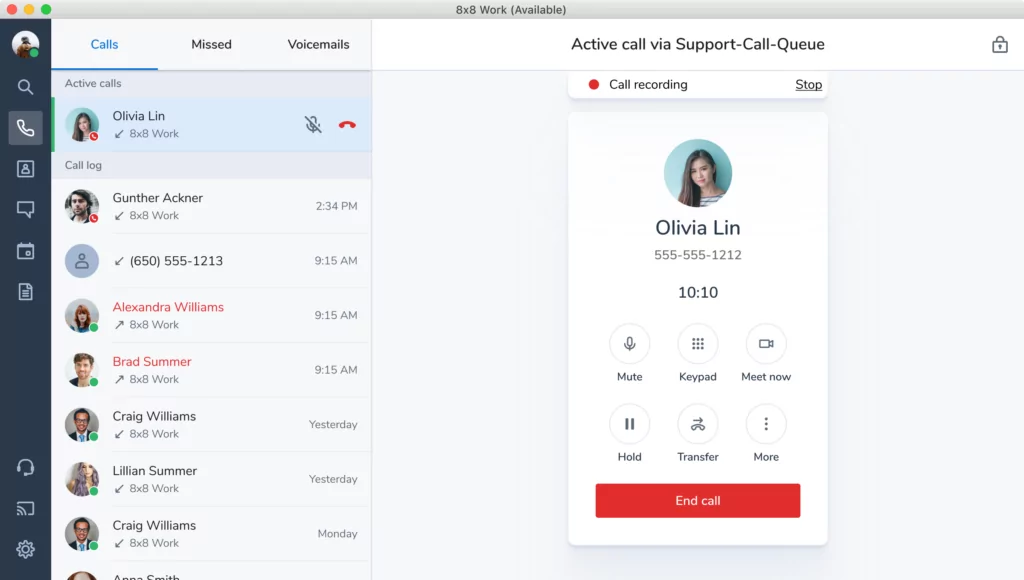
8×8 is a cloud phone system offering voice, video, and chat tools. Businesses of all sizes are eligible to use the platform, although the company removed their small business plan (Express) as of March 2023.
With 8×8, you can combine your existing phone plan with contact center tools to make unlimited phone calls in 14 countries. However, keep in mind you can only call landline numbers in 10 of them. Mobile, special, and premium numbers can only be called within Canada, Puerto Rico, the US, and the UK.
Speaking of accessible, 8×8’s basic plan also leaves much to be desired, specifically around small business features. You may find yourself paying for features you don’t need, including some technically free ones outside of 8×8 (like streaming videos through YouTube). Either way, you’re still forced to upgrade if you want better features like call whispering, skill-based routing, and ring groups.
Compared to other 3CX alternatives, you should also know 8×8 significantly limits the amount of storage you have on the basic X2 plan. If you want more than 30 days of call recording storage, you must upgrade to X4 ($44 per user per month). But even that’s not an airtight solution — you only get an extra 100 days. Unlimited media storage is locked behind their Contact Center suite, which may again force you to upgrade before you’re ready.
8×8 key features
- Unlimited calling in 14 countries (only four with mobile, special, and premium numbers)
- Video meetings
- CRM integrations
- Voicemail transcriptions
- Unlimited internet fax
8×8 pricing
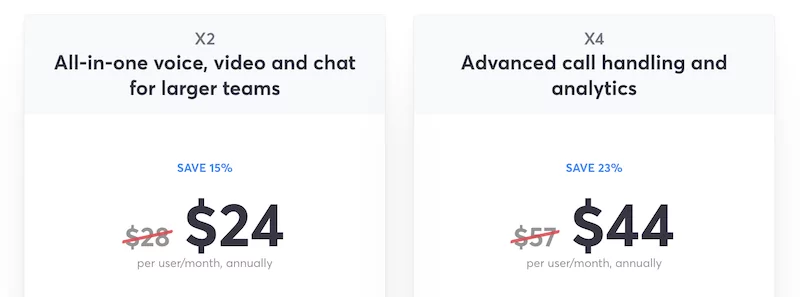
- X2: $24 per user per month for voice calls in 14 countries, 30 days of call recording storage, and CRM integrations
- X4: $44 per user per month for voice calls in 48 countries, 130 days of call recording storage, and supervisor analytics
- X6: $85 per user per month for skills-based routing, advanced reporting, and cross-platform team messaging
- X7: $110 per user per month for access to all customer channels (like chat, email, SMS, and social media) and co-browsing
- X8: $140 per user per month for the auto-dialer, quality management, and speech analytics
8. Genesys Cloud CX
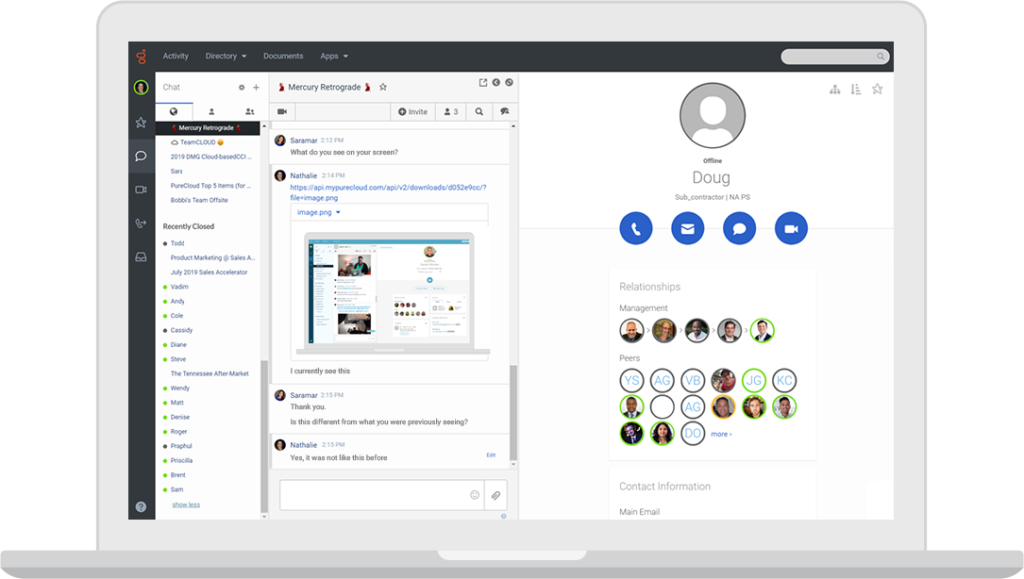
Genesys Cloud CX offers call center software to small, midsized, and enterprise businesses. Like 3CX, Genesys was built on an older telephony system (PBX) and designed primarily for on-premise deployment.
You can use Genesys Cloud CX in one of three ways:
- By signing up for a hosted plan
- By connecting the software to your third-party carrier
- By connecting your PBX to Genesys’s software
If you want to deploy Genesys Cloud CX through your on-premise software, be prepared for a steep learning curve. The SIP server deployment guide alone is 792 pages long (not including all the other documents required to learn the system).
But that’s not the only confusing hurdle to overcome with Genesys Cloud CX. Apart from the complex and time-consuming setup, you also need to download separate apps for document sharing, messaging, and employee supervision. There are four iOS apps and three Android apps for different purposes, which is unnecessarily complicated for your team.
Genesys Cloud CX key features
- IVR
- Voicebots
- Voicemail
- Call recording
- Historical reporting
Genesys Cloud CX pricing
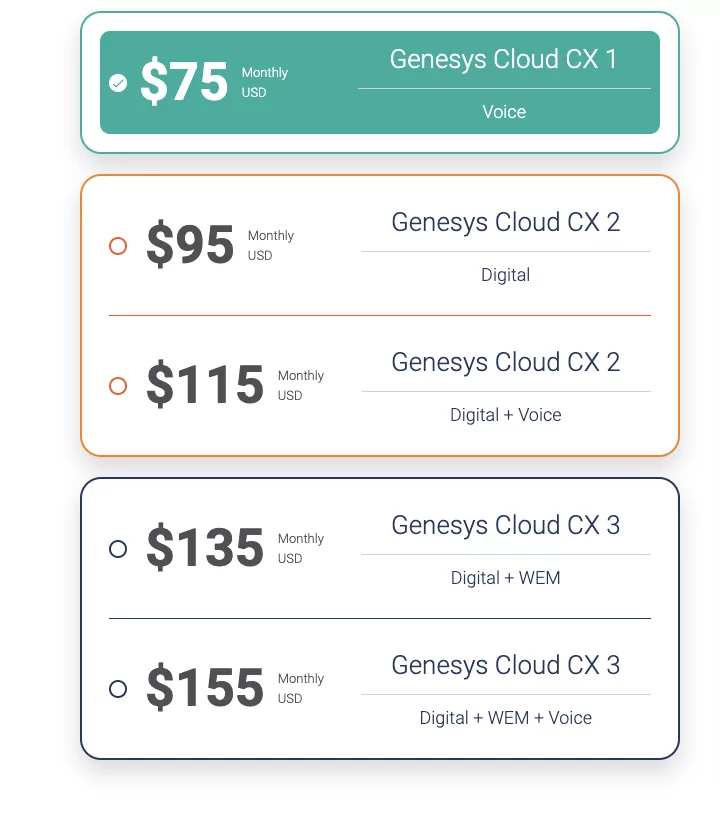
There are only three plans that allow both inbound and outbound calling:
- CX 1: $75 per user per month for voice routing, basic voicemail, and IVR
- CX 2: $115 per user per month for screen recording tools, SMS and MMS, and interaction analytics
- CX 3: $155 per user per month for employee engagement and performance, speech-to-text analytics, and workforce management tools
You also need to purchase a secondary add-on for local, toll-free, and ported numbers. In the US, this costs:
- $2 to activate the platform
- $1 per month for your subscription
- $0.015 per minute for landline and mobile numbers
- $.0090 cents a minute for inbound calls through a desk phone
- $0.0025 per call less than six seconds long
9. Aircall
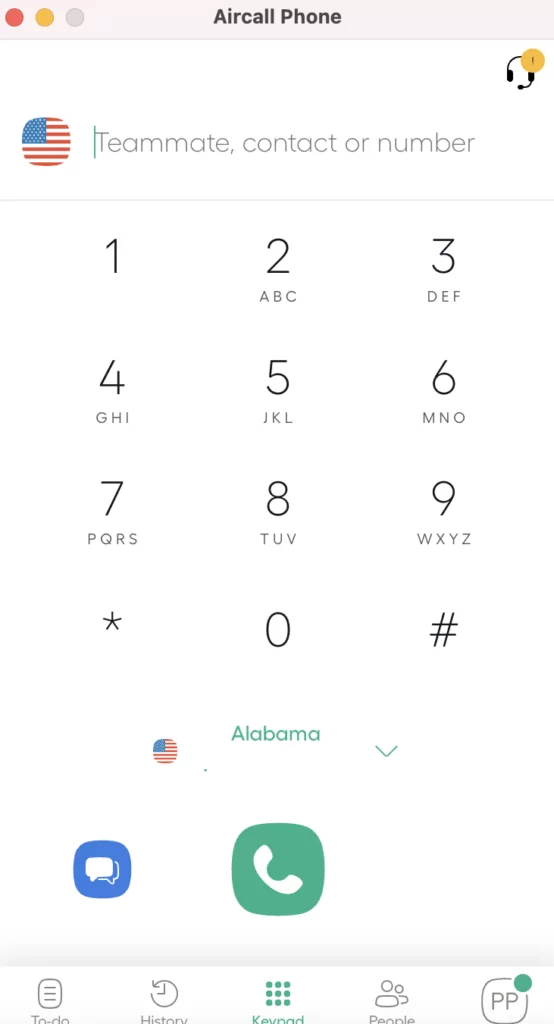
Aircall was built for helpdesks and contact centers looking to upscale with AI. Apart from the basic call center features, you can integrate your system with AI call transcriptions, a power dialer, and a multi-level IVR.
However, Aircall’s AI features aren’t enough to make up for the missing features on the basic plan. Advanced analytics, call monitoring, and call whispering are locked behind more expensive plans — which costs at least $20 per month per user extra.
But Aircall’s biggest limitation is related to SMS. You can’t send MMS messages at all, so you can’t reach out to customers with GIFs, videos, or other files. Plus, you can only send messages to users in specific countries:
- US
- Canada
- France
- Australia
- UK
And even then, you’re limited to domestic messaging only — Aircall doesn’t support international texting. For example, if you have a UK number, you can only text other UK phone numbers.
Unfortunately, this isn’t the end of Aircall’s text messaging limitations. Here are a few others to keep in mind:
- Teams are limited to just 4,000 messages per user per month (extra messages cost extra)
- You can’t send text messages and use IVR on the same number
- Texting is only free from US and Canadian numbers
Thankfully, Aircall is an outlier in the VoIP world. Other 3CX alternatives offer unlimited SMS and MMS in the US and Canada, with plenty of opportunities to send international messages at competitive rates.
Aircall key features
- 100+ third-party integrations
- SMS (no MMS supported)
- Click to dial
- IVR
- Call recording
Aircall pricing

- Essentials: $30 per user per month for unlimited inbound and outbound calls in the US and Canada, basic analytics, and shared call inboxes (three user minimum)
- Professional: $50 per user per month for call whispering, queue callback, and advanced analytics (three user minimum)
- Custom: Get a quote for custom analytics, priority support, and API developer support (no user minimum)
How we ranked the best 3CX alternatives
Our team trialed dozens of major VoIP platforms to choose the most effective alternatives to 3CX. First, we identified and crossed platforms with weaker reviews off the list. Then, we evaluated the remaining alternatives based on six major criteria:
- Customer support: How responsive is their support team?
- Cost-effectiveness: What’s the value for the price you pay?
- Features: Does the basic plan come with critical features business owners need?
- Integrations: Can you connect other tools in your tech stack (like CRMs)?
- Scalability: Can you easily add new users and phone numbers?
- Ease of use: Is the interface or dashboard intuitive to use?
We also used reviews from TrustPilot and G2 to represent better what customers had to say (like pricing problems, security issues, and other limitations).
Why teams move onto 3CX alternatives
3CX is a cloud-based PBX system available to call centers and support teams. You can opt to sign up for their hosted plan (which means 3CX manages the technical side on your behalf) or take matters into your own hands with a self-hosted plan (aka you manage everything yourself).
Although you can use 3CX to take calls on your phone or laptop, you still need to set up a SIP trunk to get started. Unfortunately, this is harder than it sounds:
- First, you have to pick a SIP trunk provider and model. Keep in mind not all models work with 3CX’s features (like SMS messages and faxing).
- Next, you must install your SIP trunk around your office. Don’t have a physical building? You’ll need to figure something out.
- Not all phone models are compatible with 3CX. Plus, none of their mobile apps are standalone tools — they’re meant to complement 3CX V18, which is their desktop softphone system.
No matter what 3CX plan you’re on, you have to purchase and configure the SIP trunk system yourself. Worried about needing help or getting lost? Unfortunately, technical support is only available if you pay $75. This can be frustrating and disappointing to small business owners with limited time and money to spare.
Speaking of money, 3CX is also known for its complicated pricing plans. Although they advertise a free plan for a max of 10 users, the basic features most businesses need — like voicemail transcriptions and business hours-based routing — are missing without upgrades. Even if you decide to pay up for more users and features, you’re still limited by the number of simultaneous calls you can take from the same phone number based on your team’s size.
The bottom line: 3CX is confusing to use and complicated to price out. Plus, security concerns may have your team looking for another solution. And if you’re like thousands of business owners scouting for a 3CX alternative, OpenPhone is likely your best option.
OpenPhone is the best 3CX alternative for growing teams
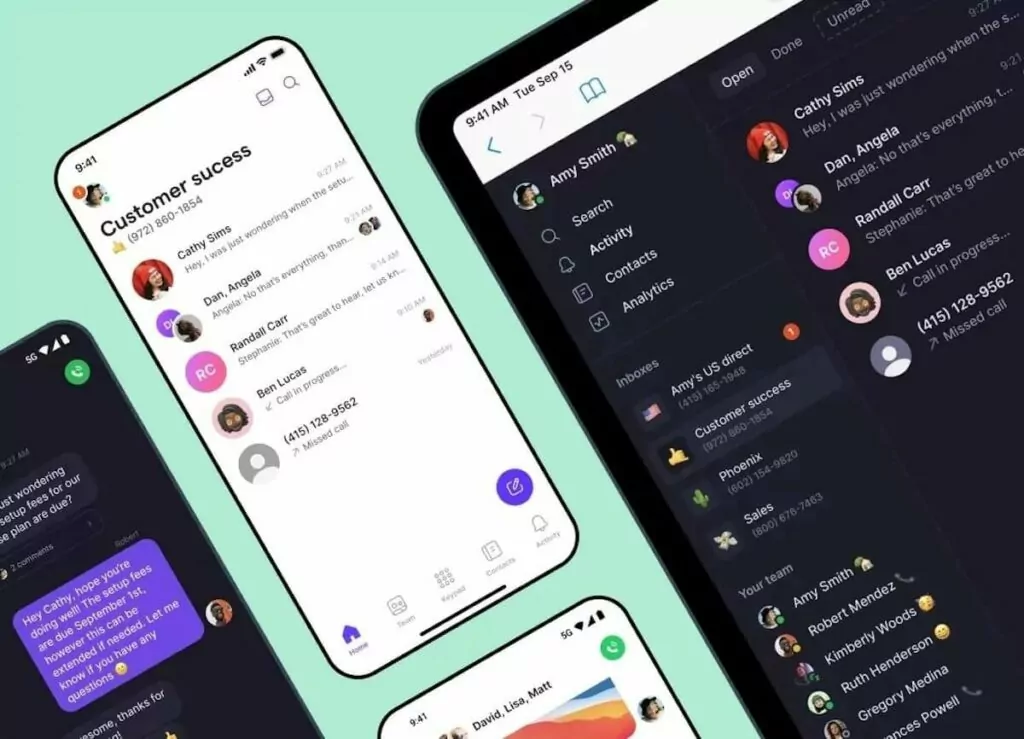
Fast-growing businesses don’t have time to navigate confusing phone systems with complicated pricing — but that’s exactly what you get when you partner with 3CX. That’s why growing teams have migrated to OpenPhone where there’s no learning curve — and your colleagues can work together to build better relationships with customers.
OpenPhone is the easiest way to scale your business communications without relying on outdated PBX systems. You don’t have to buy SIP trunks or desk phones to get started — all you need is your cell phone and an internet connection. You can have as many users as you’d like on any of our plans and only upgrade when you’re ready for more features. Plus, you can access all the critical features modern businesses need from the basic plan and get a few cherries on top, like snippets, webhooks, and auto-replies.
You can ramp up a business phone system through OpenPhone in 15 minutes or less. Just sign up for the seven-day free trial to test out the platform. Then port in your number(s) when you’re ready.
